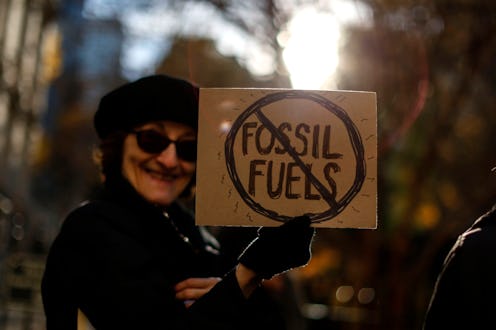Life
The Surprising History Of The People's Climate March

It's been a busy month for science. Last weekend, the March for Science kicked off a "week of action" to fight climate change, culminating in the People's Climate March on April 29. But the history of the People's Climate March is actually deeper than you might think; indeed, this is actually the second demonstration of its kind. The first climate march took place in 2014, on the eve of the UN Climate Summit in New York City. It was a historic moment in environmental activism, and this year's march promises to have a similar impact. Although three years have passed since the last large-scale demonstration — and although three years may not seem like a long time — the People's Climate March has been quite active since its inception. Let's take a look at what the movement has been up to.
On Sept. 21, 2014, a few days before world leaders gathered for the UN Climate Summit in New York addressing climate change, hundreds of thousands of demonstrators took to the city's streets for the People's Climate March. The timing was chosen not as a protest against the UN meeting, but to demonstrate the deep concern felt by ordinary people about the environment. According to the New York Times, the diverse crowd was joined by public figures like Al Gore, New York City Mayor Bill de Blasio, and even UN secretary general Ban Ki-moon. Meanwhile, demonstrators met for sister marches around the world.
In terms of crowd size, the march was a success by any estimation. According to 350.org, it helped spur the 2015 Paris Agreement, which set specific goals for the global response to climate change, and Obama acknowledged the march's power when addressing the UN summit a few days later. "Our citizens keep marching," he said. "We cannot pretend we do not hear them." In the last few years of his presidency, he went on to pass landmark environmental regulations — regulations that stand to be rolled back by the Trump administration.
Following the march, organizers took advantage of its momentum to create the Peoples Climate Movement. According to its website, the Movement is a "project of dozens of organizations working together to solve the climate crisis." Organizations range from those with an environmental focus, such as the Sierra Club, to labor groups like the American Federation of Teachers.
In 2015, the Movement shifted its focus from demonstrations to smaller-scale climate justice. This peaked with a "National Day of Action" on Oct. 14, when more than 100 events led by local organizations were held across the country. "These actions highlighted the on-the-ground realities in their cities, and tied those struggles to the national movement," reads the People's Climate Movement website.
As the presidential election loomed for most of 2016, the Movement took a different tack yet again. This time, they created a platform detailing the current state of environmental crisis and plans for fighting climate change. This document directly targets the Trump administration and conservative Congress, calling for protections of the "limited gains" made in recent years and actively resisting the president's policies. "Pushing back against the Trump agenda and at the same time pushing forward on our vision of a clean, safe world where the rights of all people are protected and expanded means we all must work together," the platform concludes.
In January, organizers announced a People's Climate March based in Washington, D.C., on April 29. As the Washington Post points out, the 2017 march takes a decidedly different approach than its predecessor, going from a message of unity to one of confrontation.
If you can't make it to the march in D.C., it's still possible to resist climate change in one of the dozens of sister marches planned nationwide. It's been pointed out before, but it's worth pointing out again: Earth is the only planet we've got.